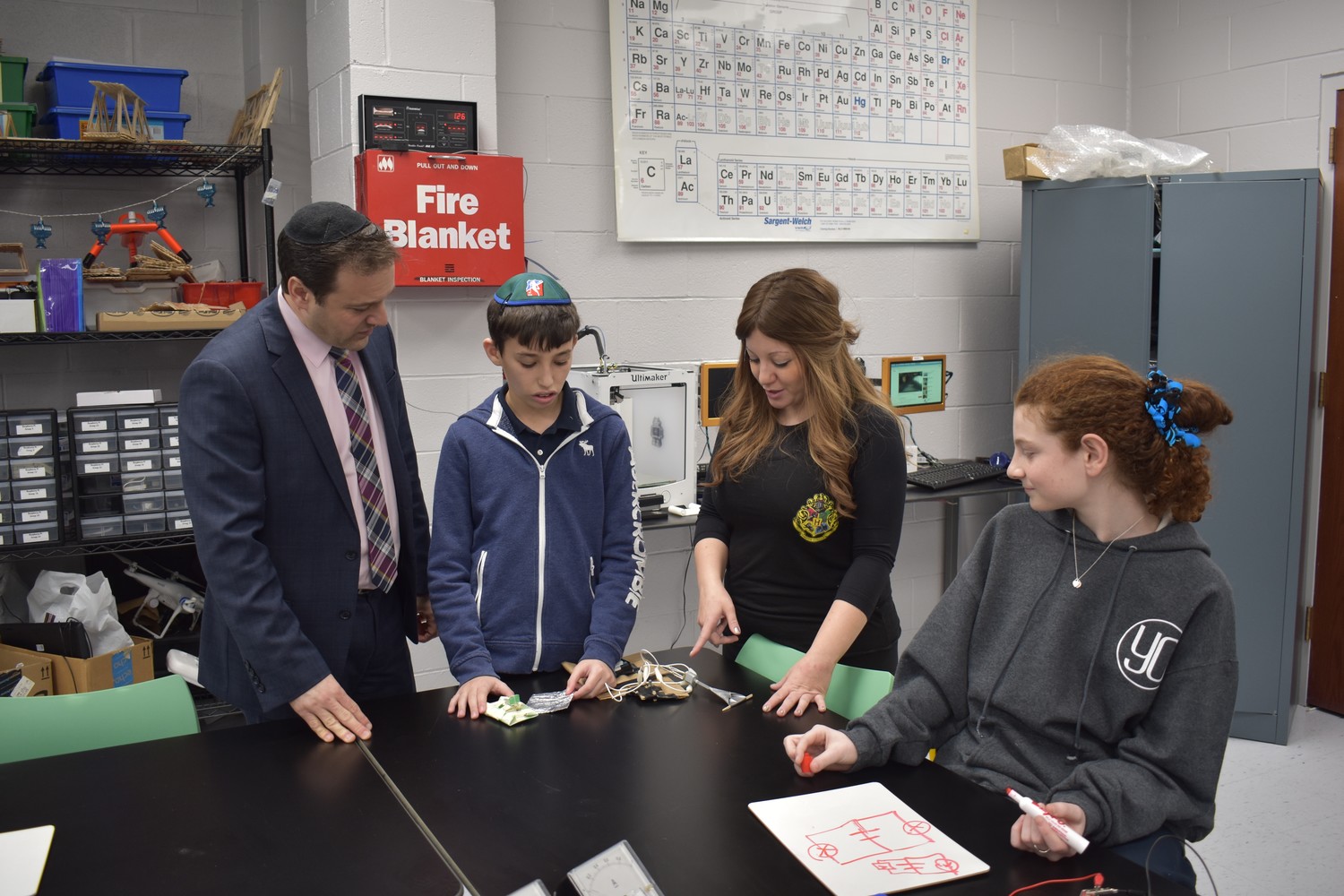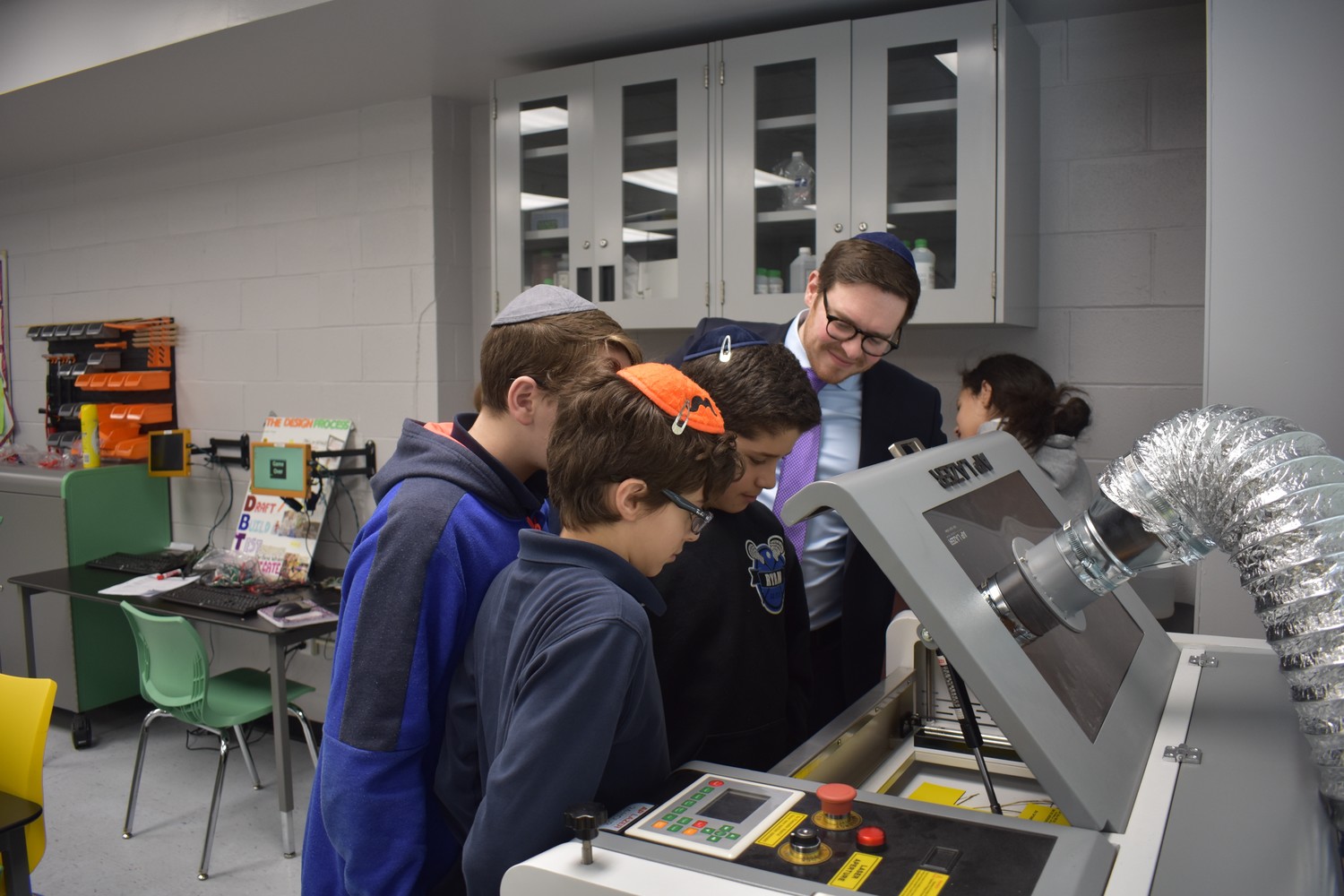Learning ‘STEMs’ from hands-on experiences
HAFTR uses latest technology to prepare students for future successes
Just a few short years ago, laser cutters and 3-D printers sounded more like they belonged in a Star Wars movie rather than in a classroom, but the Hebrew Academy of the Five Towns and Rockaway is now employing such cutting-edge technologies.
The laser cutter is the newest addition at the middle school this school year, having been added to the STEM (science, technology, engineering and mathematics) lab on the building’s second floor.
Benjamin Gross, HAFTR’s director of STEM innovation and educational technology, showed off a carving of a hawk, the school’s mascot, that students made using the cutter. He said that the device can precisely cut out the shapes fed to it by the students, and it goes beyond just carving. Pieces can be assembled into 3-D models or even be used in the electronic work done by the students. Additionally, the cutter offers an opportunity to teach students what lasers are and can do.
Collaboration among students and teachers is key. “This is about group learning, working together, problem solving,” he said. “It’s sort of like the future way of education.”
Josh Gold, the HAFTR Middle School principal, said the devices and the curriculum are tools to help prepare students not only for the next grade, but also the next phases of their lives.
“What were looking to do is create a curriculum that’s authentically inquiry driven and project based … It’s not abstract on a worksheet, but rather hands-on learning,” he said. “We want to position students to be leaders in the learning process as opposed to passive learners, so that they’re successful in an ever-changing job landscape … The teacher is a facilitator of authentic learning opportunities.”
HAFTR has implemented this educational model across all fields of study, but it’s just more visible in science and technology than it is in other disciplines, Gold said.
Roughly a dozen students chose to forgo their recess time to work on their projects on Jan. 8. Gold said a typical class wouldn’t run much differently than the informal session that was being observed by this reporter.
“It’s about shifting to a place where the student is the leader of the learning process,” he said. “We give the students the parameters and the guidelines, and we facilitate the learning experience, but it’s really the student who’s in a position to create and be the innovator.”
Science Department Chairwoman Gittel Grant also oversees the lab, and said she loves to see the different ways students solve problems. “Right now we’re doing electrical engineering, so for instance we just made lunch-box alarms,” she said. “Everyone made a lunch-box alarm that opened, and you should have seen the ideas kids came up with. You don’t have one solution. That’s the beauty of a lab like this; kids can look at each other’s [work] and say that’s better or that’s worse.”
Problem solving is one of the skills that the faculty aims to teach students. When seventh-grader Daniel Berkvoich was working on coding a pH sensor and found that the instructions were in Chinese, he didn’t despair. Rather, he adjusted. “There was this thing in Google Translate where you can take a photo and have it translate,” he said. “It had to do with where to place each wire.”
Students have a deep interest in coding, which Gross said teachers have worked to cultivate. When asked about their favorite project, seventh-graders Tommy Nandel, Benny Krysman and Corey Spitzer all agreed.
“Raspberry Pi [a small single-board computers used to teach programming]. You can make games and make cool programs, like making the turn lights on, or use a program called Scratch to put things together and make games and animations and more,” Nandel said. “I even made a robot out of it,” Krysman added.
Giving students freer rein has not only helped prepare them to work on their own in the future, but also allowed them to pursue larger projects, which they may not have been equipped to work on otherwise.
Seventh-grader Moah Rodzik was working on building a small fan, but his goal was his own invention. “You know what a smart house [a home where the lighting, heating and electronic devices can be controlled by a phone or computer] is? Well, I’m trying to make something like that for a doghouse,” he said. “I love animals. I want to make sure all animals are safe, but not just safe. I want it to be nice.”
Funding for HAFTR’s STEM labs comes from a mix of grants and donations. Grants have come from the Center for Initiatives in Jewish Education, the Legacy Heritage Fund and other organizations. “Most of it comes from the parents,” Solomon said. “The parents come in and they’re so excited and they want to donate. They want to be a part of the movement.”

 43.0°,
A Few Clouds
43.0°,
A Few Clouds 







